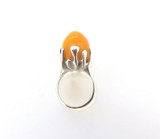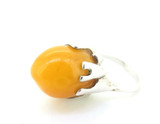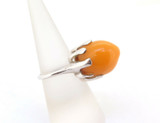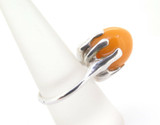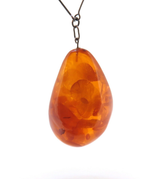Stunning high dome butterscotch amber bullet ring set into intriguing .800 silver setting. The sculptural ring is reminiscent of a cathedral spire and is also very organic looking. The amber is partly set and glued in place to ensure it is secure. The gorgeous amber is a soft opaque yellowy tone with lighter swirls and circles within.
The back of the ring band is stamped clearly with E.B. the makers stamp, unfortunately, the maker cannot be found. The Minerva stamp facing right, indicates the time period of manufacture was between 1963 - 1986, the number 3. for .800 silver and W for the city of Warszawa. This ring was part of a vintage collection purchased from one owner who acquired the pieces from 1963 - 1970's in Poland. It is in great condition and is ready to wear. Definitely a statement piece that will be a talking point at any event.
Dimensions are as follows:
Height of Ring 2 cm x width 1.4 cm x thickness 1.3 cm
Ring Size N
Weight 7.33 grams
A Little History of Polish Amber
Polish amber Jewellery had a major resurgence from the 1960s onwards. Though historically, the oldest traces of amber workshops on Polish soil date back to over 6000 years ago. Examples of which were found in the Niedźwiedziówka settlement, near the coastal city of Gdańsk. Ambers origins were a mystery at that time and could only be explained with a myth.
This myth became a popular Polish legend that the amber nuggets found washed up on the beaches were actually debris from the sea goddess Jurata's underwater palace. Her residence had been destroyed, in a fit of jealously by a mighty god called Perkin, who was infuriated by her relationship with a fisherman. She dared to fall in love with a mortal and he sent a lightning bolt from the sky, sadly killing her and shattering her amber palace into pieces.
from Lucjan Siemieński, Polish, Ruthenian & Lithuanian Legends and Tales, 1845
It is more widely known about the origins of amber today, that before it washed up on the shores of the Black Sea, it originated from a coniferous tree called 'Araucarias of the genus Agathis' in what we now call Scandinavia. These trees were prolific producers of liquid gold tree sap that fossilised into precious amber over 400 million years. The trees produced the sap to protect from boring insects and heal injuries. The name Amber is essentially restricted to fossil resin of Baltic provenance.




